How to Open a 5 Gallon Bucket Lid
I often get asked- "what's the easiest way to grow mushrooms at home?"
And to be honest, the true answer depends on your specific situation.
For example…
Do you have a flow hood? Have you tried growing mushrooms before? Do you have access to spawn?
If you are already a little confused, don't fret!
In this post, I'll go over how to grow mushrooms in a 5 gallon bucket, which is one of the easiestand most fruitfulmethods for growing mushrooms- that almost anyone can do at home.
Why a Five Gallon Bucket?
I'll admit, growing mushrooms can get complicated… but it doesn't have to be that way.
Sometimes it can be dirt simple- and that's why I love the 5 gallon bucket method.
- It requires no special skills or previous experience.
- It requires no expensive and specialized equipment.
- It can produce ametric whack-ton of fresh mushrooms at home, with little effort.
So… are you ready to grow lots of fresh mushrooms at home?
Me too.
Let's get started!
5 Gallon Bucket Mushroom Grow
Let's start by first outlining a few things that you'll need to get, and then go over the step by step method for growing mushrooms in a 5 gallon bucket.
Keep in mind that these are mostly suggestions and stuff that has worked well for me. For every piece of equipment and step in the process, there is likely an alternative that will work just as well. If you have your own methods, feel free to let me know in the comments below!
WHAT YOU NEED
1. Five Gallon Bucket With Lid
The bucket will act as the "fruiting container" to hold the substrate that the mushrooms will grow from.
You can easily find these buckets for relatively cheap at Home Depot, Lowes, or any other hardware store.
You can also use any old bucket you may have laying around your house- but be mindful of the chemicals that might have been in there before.
If you're planning on eating your mushrooms it may be best to start with a clean new bucket. Also, make sure to get a lid for your bucket so you can seal it off while the mushrooms are colonizing.
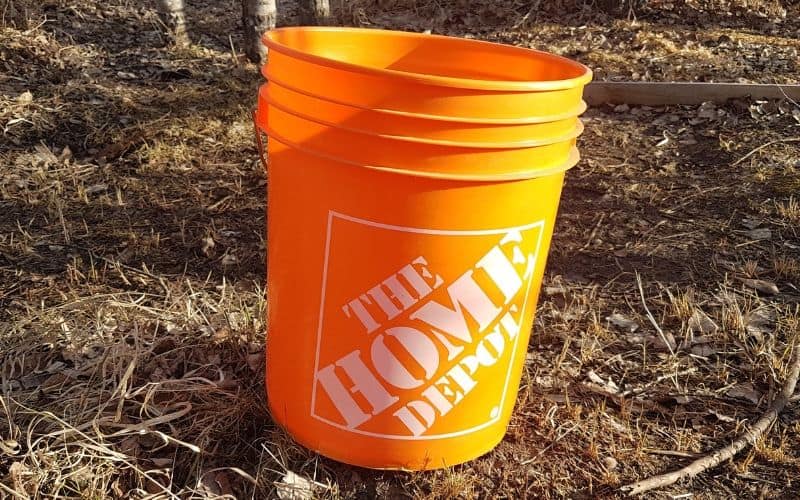
2. Power Drill With A ¼" Bit
You'll need a drill with a ¼" bit to punch holes all around the bucket.
Some prefer to use a larger bit, (or even a hole saw) but I have found the most success with these smaller 1/4″ holes.
3. Aspen Wood Chips
The wood chips will be the substrate for your mushrooms to grow on.
You can use most hardwood species, it doesn't necessarily have to be aspen. Use what you have access to.
The reason I suggest Aspen is because you can often find them at your local pet store, where they are sold as bedding for hamsters and other small animals.
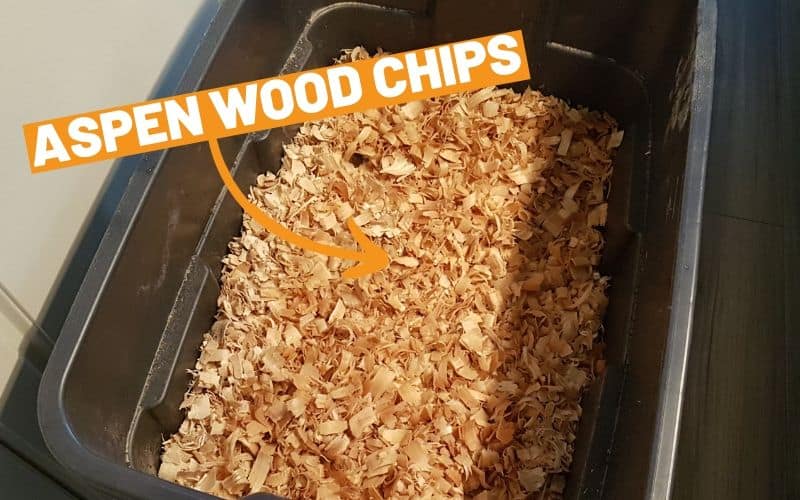
4. Large Plastic Tote
This will be used to soak the chip in hot water.
Get on that is around 13 gallons or so, which should be plenty of room to soak your chips.
Of course, you can soak your chips in other five gallon buckets, in your bathtub, whatever works… I just like the tote because it's clean and easy to use.
5. Oyster Mushroom Grain Spawn
This is the crucial ingredient!
If you have some experience, you can make your own spawn, but for most starting out, it's easiest to get pre-made spawn.
You'll want to get your spawn from a trusted supplier (send us a message for recommendations) and be sure to have a plan ready to use your spawn soon after you get it.
Spawn will stay good on a shelf or in the fridge for a while, but fresher is always better… keep that mycelium running!
Most Oysters species will work great, specifically Pink Oysters, Blue Oysters and Pearl Oysters.
You may be able to grow other species this way (Lion's Mane for example) but it's best to stick to something prolific and aggressive like oysters, especially if it's your first grow.
Plus, Oyster mushrooms are absolutely delicious, so it's not like you are compromising….
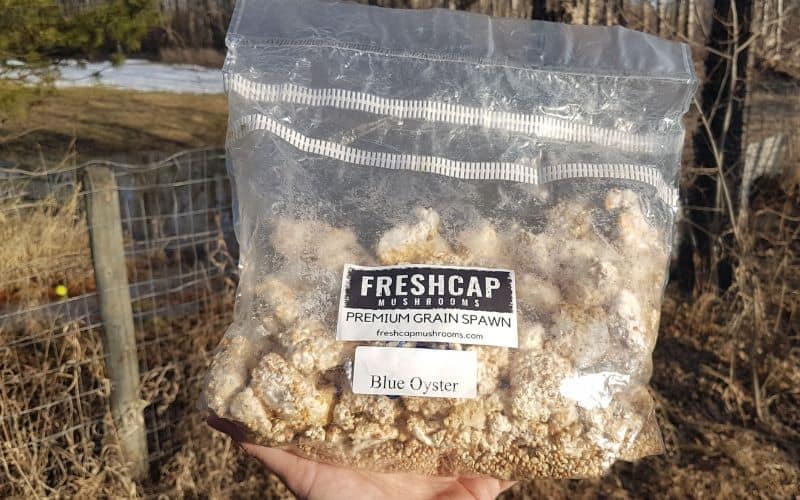
6. Other
It also doesn't hurt to ensure you have a spray bottle for keeping your mushrooms moist, and a spare kitchen trash bag for covering your bucket while it's colonizing.
STEP BY STEP
Gathered all your materials?
Great- it's time to grow some mushrooms!
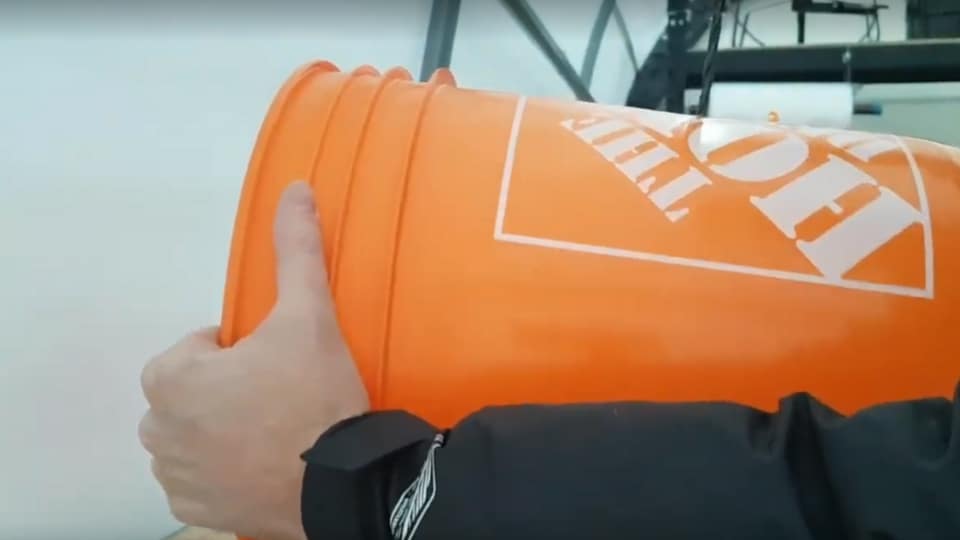
Step 1: Drill Holes in a Plastic 5 Gallon Bucket
First step is to drill holes all around the outside of your bucket. There's no exact science here, just drill holes every few inches all the way around.
I find that a ¼" drill bit works great- it's big enough for the mushrooms to fruit from, but not too big as to make the substrate dry out too quickly.
Some people use a hole saw to get larger ½"-¾" holes, but I really don't think this is advisable.
You can also drill a few smaller holes in the bottom (⅛" or so) to allow excess water to drain from the bottom, but this is not 100% necessary either.
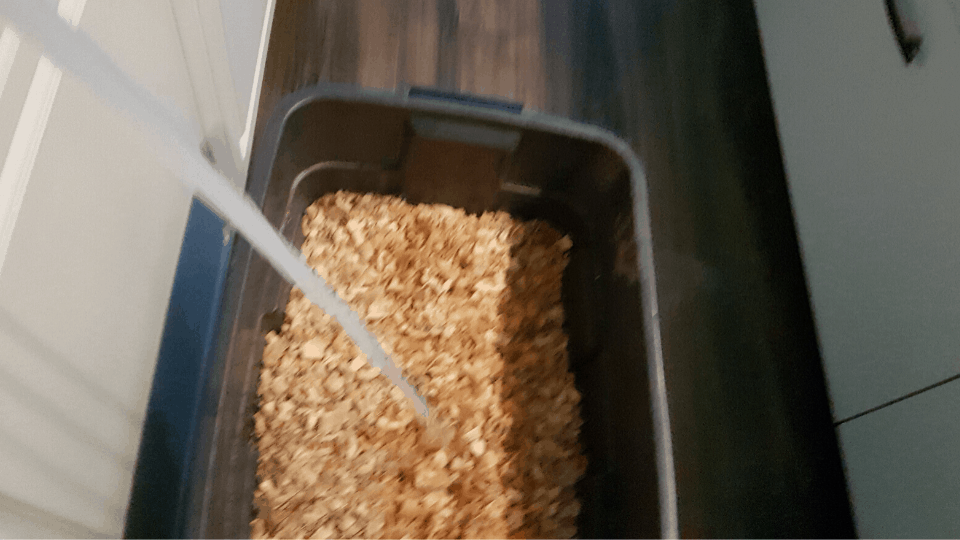
Step 2: "Lazy" Pasteurization of Wood Chips
The reason we use straight wood chips (no added bran, soy ect.) is because the wood chips alone are not likely to contaminate.
You could also use straw, but without a full pasteurization there is a high chance of contamination.
Wood chips can be treated by simply soaking them overnight in hot tap water, as long as your hot water tank is hot enough.
Place the chips in a large tote, and fill with hot water. Your chips will float, so you might need to place something heavy on top to keep them submerged.
The goal is to get the water between 65-85 deg C.
If you can't achieve that with water from the tap, add a little boiling water from the stove or kettle to bring the temperature up.
Again, this process doesn't need to be exact.
The purpose of the hot water is two fold:
- It partially pasteurizes the wood chips, killing some of the potential contaminants
- It hydrates and softens the wood chips so they are more easily colonized by the grain spawn
Let your chips sit in the hot water for 8+ hours, or until they have completely cooled off.
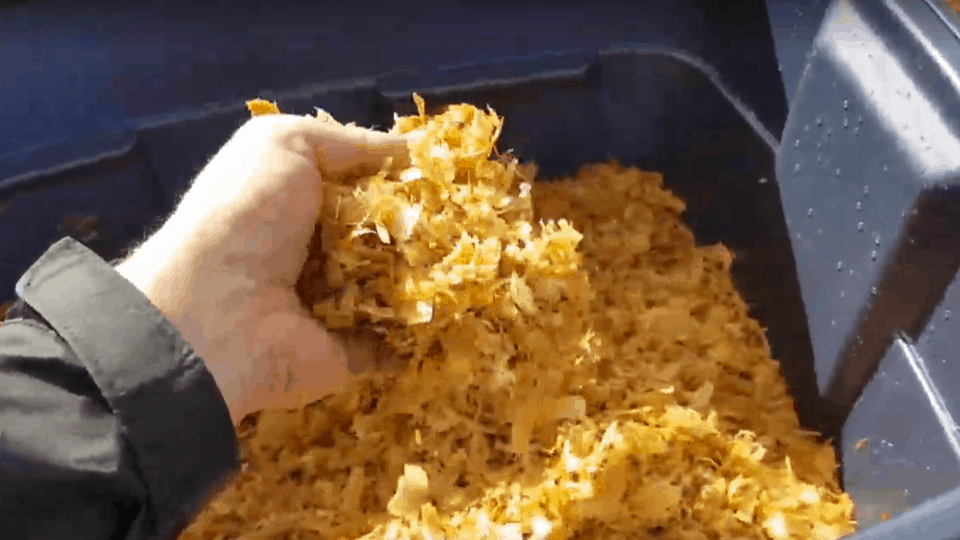
Step 3: Cool Overnight / Drain
Leave the wood chips to soak overnight or longer so that they can get sufficiently softened, pasteurized and have a chance to completely cool off.
Adding grain spawn to piping-hot chips will likely kill off the mycelium, so ensure it is cool to the touch.
You'll also want to drain off the excess water.
The chips should be fully hydrated, but not dripping wet. Do whatever works and makes the least amount of mess. You can drain them down a tub, or even just drain them in your yard.
You can also just drain the chips by squeezing them out as you are adding handfuls to your bucket.
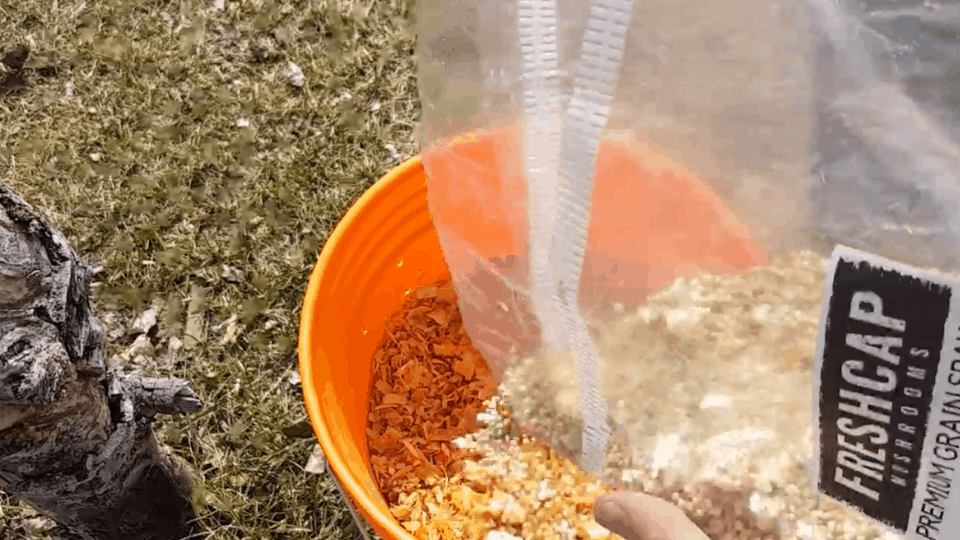
Step 4: Add Spawn To The Wood Chips
It's time to inoculate your bucket!
To do this, simply build up alternating layers of wood chips and spawn until the bucket is full. Each layer of wood chips should be around 1.5" thick, topped off with a thin layer of spawn.
Again, the science here is not exact.
You want to use a spawn rate of around 5-10%, which means you'll need about 2.5-5 lbs of grain spawn for each 5 gallon bucket.
A 10% spawn rate will colonize the bucket faster, and comes with a higher chance of success- but you can easily get away with less.
No need to be sterile here, since the wood chips aren't prone to contamination. You can wear nitrile gloves if you are handling the spawn directly, but it is not necessary.
Step 5: Colonize In A Cool Dark Place
Once the bucket is inoculated in layers, toss a lid on and put it somewhere to colonize. Nothing fancy here- just keep it out of the sun, in a cool location if possible.
Best bet is to put it in a basement or cool garage.
You can leave it in the dark, but that is not crucial- it will still colonize fine if exposed to ambient light.
The important part is that it doesn't dry out. An easy way to avoid this is to loosely drape a plastic bag over the bucket while it's colonizing. This will allow the mushrooms to breathe, but help retain the humidity.
Depending on temperatures, spawn rate, and species, your bucket should be fully colonized in 10-21 days. If you want, feel free to take a peek under the lid after a week or so. Dig under the chips and take a look at the mycelium. You should see that it is slowly expanding and working it's way across the chips.
If you see no growth, or smell anything funky, it means that your bucket was contaminated. This could be from bad spawn, contaminated chips, or poor environmental conditions. If that is the case, it's time to toss the bucket and try again.
…But that's not going to happen… right?!?!
Once the bucket is fully colonized, pins will start to form. You should notice small clusters forming through some of the holes in the bucket.
Once you see this, you know it's time to fruit!
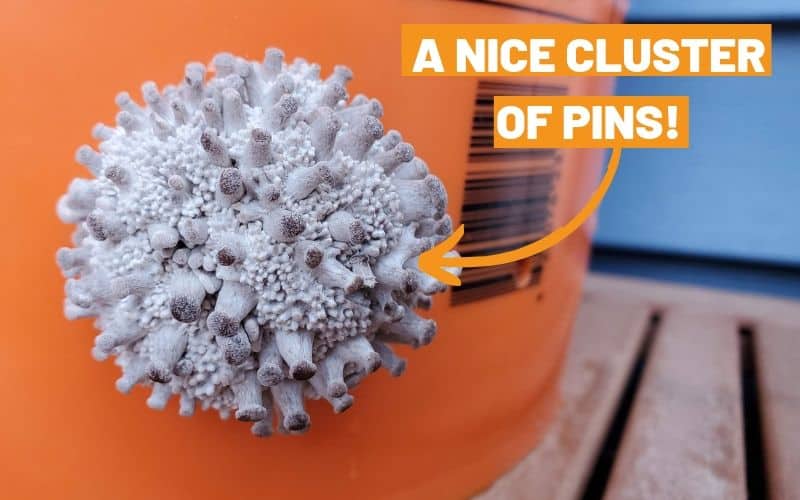
Step 6: Fruit
Your hard work has paid off and it's time to fruit the mushrooms.
Wooo hooo!
Where you fruit them depends on your situation, time of year, climate ect…
Personally, I like to fruit them outside in the spring, summer and fall.
Place your bucket in a well shaded area, away from the wind, and preferably somewhere where you can maintain a relatively high humidity.
Some examples of good fruiting locations are:
- In tall grass under the shade of trees
- In a corner of your deck/patio that doesn't get much sun
- In a shed or garage
The most important thing is to make sure the pins do not dry out. If they get too dry, they will "abort" and fail to grow into full sized mushrooms. If the location you chose is too windy, you can try to drape a plastic bag loosely over the bucket, so that it still has a chance to breathe.
Also, it helps to have a spray bottle handy so that you can soak the mushrooms down a few times per day.
Once they start pinning, mushrooms grow fast! You should expect to go from pins to full sized mushrooms in less than ten days, sometimes even faster.
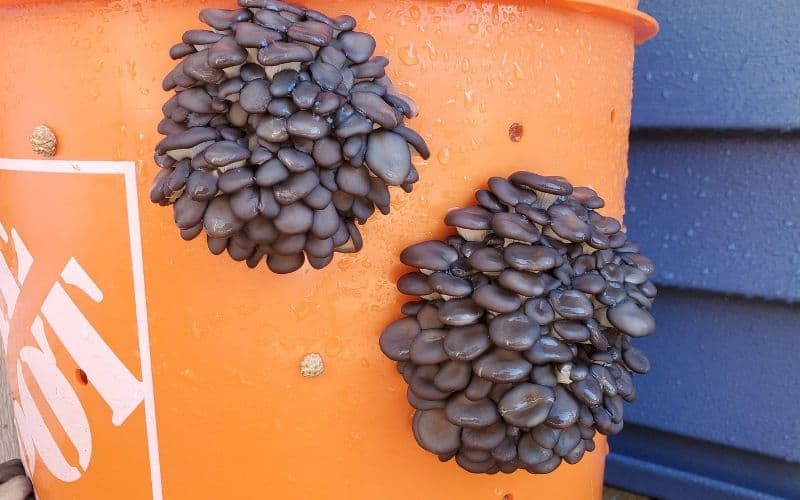
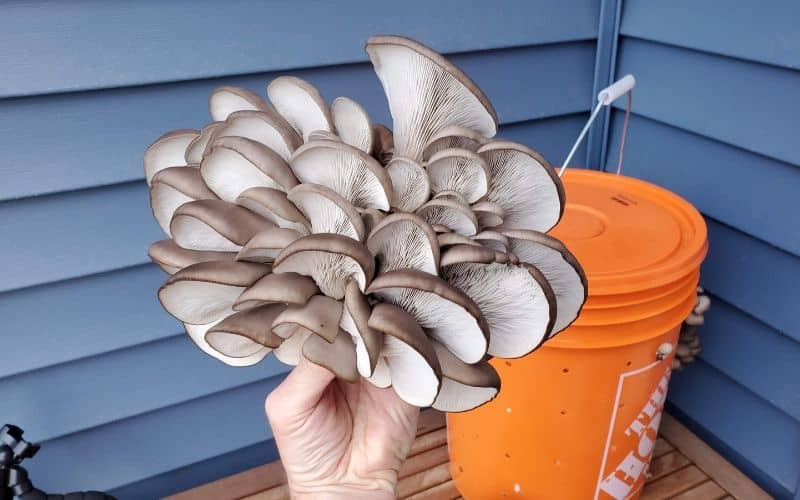
Step 7: Harvest and Second Flush
You'll know it's time to harvest the mushrooms when it looks like the caps are starting to curl up.
This is the point when the mushrooms want to release their spores, so you'll want to make sure you harvest them before that stage.
You can also harvest them earlier.
If you're growing them outside, harvesting them early reduces the chance of bugs burrowing into and feeding off your fruits.
Harvest the oysters in whole clusters instead of picking them off one by one. The easiest way to do this is to simply cut the whole cluster off at the back against the bucket with a sharp knife.
Now, you officially have the freshest Oysters in town!
You can cook them right away, or store them in the fridge for a few days.
Remember that Oysters do not have a great shelf life, so the earlier you are able to use them the better.
Homegrown Oysters are usually WAY nicer than the ones you get in the stores. That's because Oysters are relatively delicate, do not travel well, and do not have a long shelf life. You really can't beat the quality of homegrown oysters.
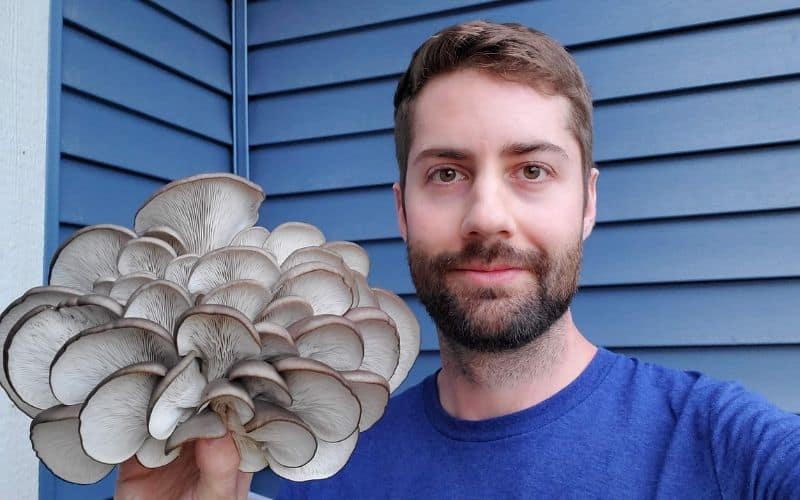
FAQ and Troubleshooting
Having issues with your grow? Growing mushrooms like this is easy, but it doesn't always go as smooth as planned.
Here are some common issues and how to resolve them.
+ How Long Does It Take To Colonize?
How long it takes to colonize the bucket depends on temperature, spawn rate (ie. how much spawn you used) and the species of mushroom.
For Oysters on aspen wood chips at a spawn rate of 5-10%, it should take anywhere from 10-21 days to colonize fully.
Cooler conditions will slow the growth, but too warm and they will not grow at all. Anywhere from ~10 deg C- 21 deg C should be just fine.
+ My Oysters Aren't Pinning
If your Oysters aren't pinning it could be for a couple of reasons.
1. Your Bucket is contaminated
Did the bucket fully colonize? Check to see if the mycelium has grown through the wood chips. If not, you may have to wait longer or it has become contaminated, in which case it is time to start over.
2. It is too dry
Oysters (and most other mushrooms in general) need a really high humidity to form pins. Try draping a plastic bag over the bucket to maintain a higher humidity, or try spraying near the holes with a spray bottle a few times per day.
+ They Are Aborting
If you see pins, but they stop growing, it is likely because there was a drop in humidity.
Sometimes these pins can be revived with a good spraying, but often if the pins get too dry, they are not going to grow anymore. Any "aborted" pins can just be picked off the bucket.
+ When Can I Harvest?
Harvest the mushrooms is usually best right before the caps start to curl up, indicating that they are done with the life cycle and about to drop spores. After they drop spores, the quality of the fruits will decline rapidly. Sometimes it's better to harvest the mushrooms long before this stage.
+ What About Bugs
Bugs can be a problem depending on the time of year you're growing and where you're located.
In my area (Central Alberta) we can get gnats that burrow into the fruit and lay eggs, and eventually degrade the fruit completely.
The only real way around this is to harvest the fruits before they get a chance to ruin them. Before cooking them up, slice a few in half to ensure they are not full of these gross bugs.
+ Can I Get A Second Flush?
Mushrooms just have so much to give!
Leave your bucket in a suitable location and you are very likely to get a second, third or even fourth "flush" of mushrooms.
Alternatively, you can remove the wood chips from the bucket in myceliated "discs" and lay them in a garden to get more mushrooms through the summer and fall.
+ Can I Use Straw Instead?
Oyster mushrooms will grow well on a variety of substrates, including straw, coffee grounds, soy hulls and much more.
I would not recommend straw for this method unless you are able to do a more thorough pasteurization using a large 55 gallon drum. The reason for this is that straw is not nearly as clean as wood chips and there is a much higher chance of contamination.
Keep in mind, this is from personal experience, so your mileage may vary.
Tony Shields
Hi' I'm Tony. I've dedicated a ton of time to learn all about the amazing world of mushrooms- and would love to share that information with you! I am particularily passionate about growing mushrooms, and teaching others how to do the same.
How to Open a 5 Gallon Bucket Lid
Source: https://learn.freshcap.com/growing/bucket-grow/
0 Response to "How to Open a 5 Gallon Bucket Lid"
Post a Comment